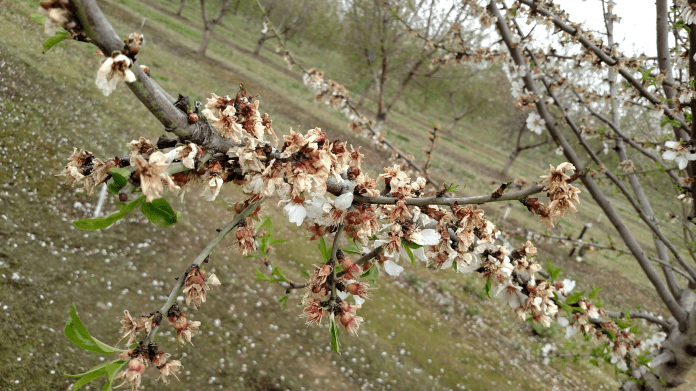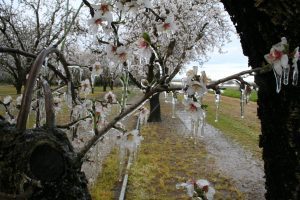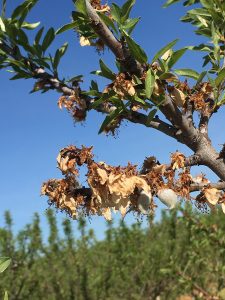
Bacterial blast and canker caused by the bacterium Pseudomonas syringae can be extremely damaging to almond yields due to bloom loss and branch dieback. Significant crop loss was reported in the Sacramento Valley in 2017 and 2018, and in the San Joaquin Valley in 2017 and 2019. Bacterial blast also hit some varieties in the Regional Almond Variety Trials in Butte and Madera counties in 2017 and 2019, but in 2020 and 2021 excellent bloom conditions prevailed and almond blast wasn’t a problem, according to Luke Milliron, UCCE orchard systems advisor for Butte, Glenn and Tehama counties.
Kasugamycin has been used as a preventative treatment for almond blast over the last few years. An emergency Section 18 registration was applied for and approved in select counties in 2020, 2021 and 2022, Milliron said.
“Basically, it’s in counties where we’ve documented that there’s been blast damage in the past, and certainly there was big blast damage in my area in 2017 and 2018,” Million said, adding he and other farm advisors documented crop loss of 20% to 40% with part of the damage due to almond blast.
Crop Loss to Almond Blast
In 2017, the Regional Almond Variety Trial at California State University, Chico experienced four nights below 30 degrees F coinciding with full bloom, and significant damage was observed. Copper has been the only main control measure for this disease, but copper resistance in P. syringae is widespread, and copper sprays are believed to be mostly ineffective at controlling this pathogen, Milliron said.
The bacterium P. syringae can cause both blast (in blossoms) and canker (in wood). It is ubiquitous on surfaces in almond orchards, but it only causes infections under wet and freezing conditions, Milliron said, adding these conditions stress the tree and make them more vulnerable to infection.
In 2022, the bloom period was dry, and with expenses high and prices low, growers didn’t spray for blast, Milliron said, adding that severe freezing conditions came later in bloom, but it didn’t result in significant blast damage.
Jim Adaskaveg, professor and plant pathologist at the University of California, Riverside, agreed. “Last year (2022) was a strange year,” he said, “and there was minimal precipitation during the freezes.”
This meant a lot of the freeze did direct damage to the embryo and within the flower, Adaskaveg continued. “It was so dry that when the cold came, bacterial populations did not increase and were not distributed to the flower parts from the tree surfaces by rain,” he said, so blast really wasn’t a major factor.
Low temperatures alone won’t result in blast; it requires cold, wet and freezing conditions. “Because we had a dry freeze, I think that’s why we only saw direct freeze damage, but not blast damage,” Milliron said.
When to Spray
Pseudomonas syringae is a bacterial pathogen. “It’s an epiphytic organism, meaning it grows on the surface of plants. Rain or heavy dews are needed to move the bacteria in the water on the tree,” Adaskaveg explained.
In order for blast to occur, it requires cold, wet weather from rainfall or high moisture from dews. With heavy dews, the water carrying the bacteria drips, or rainfall splashing on the plant moves the bacteria, Adaskaveg said.
In some cases, growers applied kasugamycin in 2022 and saw results, Adaskaveg said. “In other cases, I don’t think it helped. It just got so cold that it damaged the flower, and whether you had kasugamycin there or not, it didn’t seem to help in those cases. I attribute that to the low-rainfall, low-wetness year during the time of flowering.”
Kasugamycin is an expensive material, so growers aren’t going to prophylactically apply it, Milliron said, but strongly recommends they make the application in advance of a combination of wetness and freezing temperatures during bloom.
“Just monitor the weather. If there’s warm weather and low rainfall.” Adaskaveg advises it’s not necessary to spray for blast.
If conditions are favorable for blast, mix kasugamycin into the tank with other bloom sprays and apply it, Adaskaveg said.
Kasugamycin is a protective treatment. “It’s like buying an insurance policy,” Adaskaveg said. Growers only need to spray when conditions warrant it; when there’s frost, rain and wetness, he added.
Kasugamycin has a residual life of about a week. “If there’s a forecast for five or six days out for cold weather, really cold weather next week, then it is time to put it on,” Adaskaveg said.
Kasugamycin is a tool in the toolbox when it’s needed, Milliron said.

Copper vs. Kasugamycin
“Copper still works in some areas, but there’s copper resistance in a lot of areas. People have said they’ve mixed mancozeb with copper like on walnut blight. We’ve tried that, and it does help, but it’s not as good as kasugamycin. Kasugamycin is the most effective, and it is the highest-performance treatment for bacterial blasts that we have identified,” Adaskaveg said.
Copper also causes damage. If leaves are coming out at the same time as bloom, leaf injury can occur.
“Copper has some efficacy, but there’s a lot of pushback by the industry that they don’t want to use copper because of the potential toxicity to young leaves coming out,” Adaskaveg said.
“Leaf loss causes a reduction in the carbohydrate balance in the tree, and nobody wants to lose their leaves at that time of year. So, growers are skeptical and very cautious about using copper,” Adaskaveg said, adding that kasugamycin is a better choice for combating almond blast.

Varieties
The Independence variety has problems with blast along with other varieties.
Adaskaveg hasn’t scientifically documented this, but he personally thinks increased problems with blast could be due to tree nutrition, too. “Trees that are heavily fertilized with nitrogen, or overfertilized with nitrogen, are going to be more susceptible,” he said.
Adaskaveg advises growers not to overfertilize. “A lot of guys try to get ahead. They have to get their nitrogen requirements in, and they start their fertilizer program right at bloom. But that could be a dangerous thing if it’s cold and wet,” he said, adding not only could it increase problems with blast, but the nitrogen could also leach into groundwater.
Kasugamycin Approval
Kasugamycin has been available to growers through a Section 18 registration, and the Environmental Protection Agency (EPA) was supposed to approve it with a full section 3 label in March of 2021, but it was postponed until September 2022 and now March 2023.
“We were all hoping that we don’t have to file another Section 18 for next year (2023),” Adaskaveg said, but with another new PRIA date set by the EPA, a Section 18 will have to be submitted this fall so that Kasumin is available again in the 2023 spring season.
The EPA has all the information, and they’ve said they are going to approve it, but we’re going to have to wait, Adaskaveg said.
“The EPA has to address the Endangered Species Act for all pesticides, and this has caused delays for many new pesticides submitted to be registered,” Adaskaveg said, adding he will be working with UPL, the registrant, and The Almond Alliance to apply for a Section 18 for the 2023 season.










